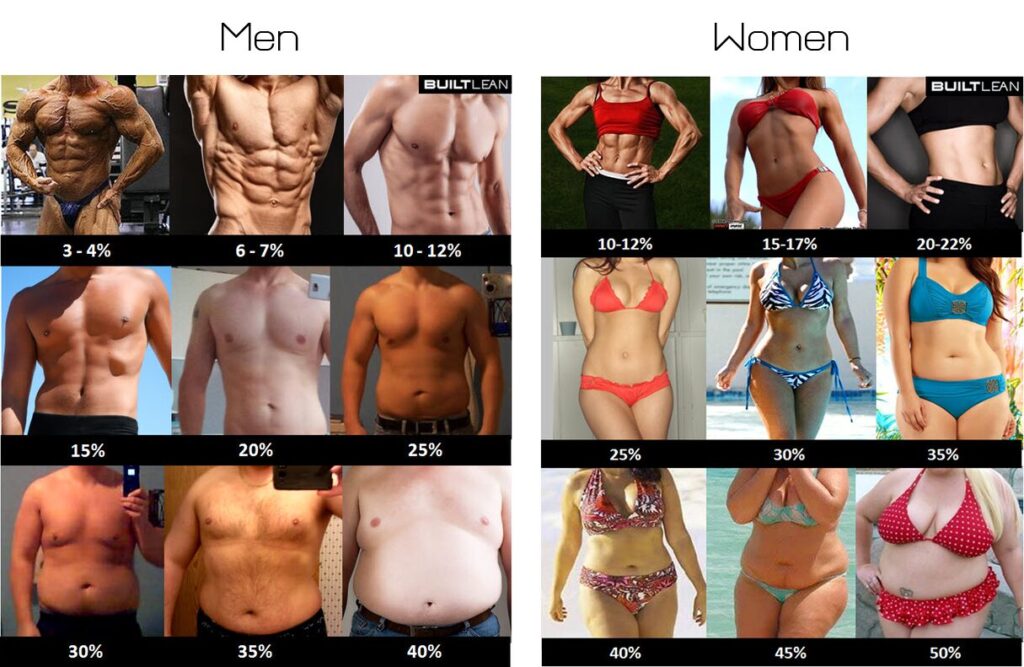How To Get Six Pack Abs
I’m going to tell you something that will likely surprise you.
You already have abs.
They are there, despite what level of physical fitness or body fat percentage you are currently at. The trick is, of course, getting them to show.
While it’s true, doing abdominal exercises will help grow your abdominal muscles, your energy is much better spent elsewhere. Let’s get into that now.
Abdominal Muscles and Body Fat Percentage
As we discussed, you already have abs (yay).
Our primary focus in this endeavor will be to lose as much body fat as possible, in order to get us to a body fat percentage that will reveal visible abs.
How much body fat do I have to lose?
How many orphaned bears are there in northern California?
Everyone is different. Everyone has a different body fat percentage.
For some people, they will need to lose 10lbs, for others, they will need to lose 50lbs.
A good rule of thumb, however, is to try and get to 10% body fat (for men) and about 20% body fat (for women) in order get visible abs. Here are some examples of body fat percentages below.
Fat Loss and Muscle Mass
Having more muscle on your frame has a myriad of benefits, besides just looking more jacked (which of course is the best benefit).
The main benefit in this case, with regards to body fat percentage, is the effect muscle mass has on our on TDEE (Total Daily Energy Expenditure).
Muscle mass is more metabolically active that other tissue (such as fat) and therefore requires more energy (calories) to maintain. In addition, protein intake, which is essential for muscle growth, has the highest thermogenic effect of any of the macronutrients.
Simply put, we burn more many more calories at rest while holding more muscle mass than we would without it.
So, in addition to making changes to your diet, as well as incorporating cardio training to your lifestyle, it’s important you also make a concerted effort to put on lean muscle mass.
Losing Fat: An Inconvenient Truth
There is only one way to lose body fat as a human being.
I don’t care what your Aunt told you about Ozempic, or what your yoga friend told you about the kombucha milkshake.
The ONLY way to lose body fat is by being in a calorie deficit, that is, to expend more calories than you take in.
“But Austin, I did that and it didn’t work. I ate nothing but salads for a whole week and didn’t lose a single pound!”
But what about the donuts on that Wednesday evening and the 8 mixed drinks at the bar on Saturday night Karen?
You are not impervious from thermogenesis.
You are not the only human on Earth who has somehow defied our survival mechanism that has evolved over tens of thousands of years.
You do not have a hormone deficiency preventing you from losing weight.
Go tell people in third world countries, with a straight face, that you have been struggling to lose weight but have been “eating clean”.
The only person you’re fooling is yourself.
The (Only) 2 Methods Of Losing Fat
There are only 2 methods to lose body fat. And, guess what, they both result in a calorie deficit, which is the only way us humans can bring down our body weight.
The two methods are as follows;
- Move more
- Eat less
Method 1: Move More
This one should make sense.
The more active we are, the more calories we burn. The more calories we burn, the more we need to eat to maintain our weight.
The average person burns between 200-350 calories walking for 1 hour, depending on their weight. A heavier person burns more calories doing the same exercise than a lighter person.
It takes more energy to get something that weighs 300lbs from A to B than it does someone who is 150lbs.
Method 2: Eat Less
We all have parts of our diet that we can clean up. Healthy foods aren’t fun, but they are necessary.
I have a friend that drinks about 3 sodas a day. That’s almost 500 calories.
He’s been the same weight for about 2 years now and has been “trying” to lose weight for the majority of that time.
If he switched out the sodas for their diet counterparts – he would start seeing progress. That’s ALL he would need to do.
500 calories is a lot. It’s about an hour spent jogging. I hate jogging.
But we can drink 500 calories in about 3 seconds if we wanted to. It is infinitely easier to consume calories than it is to burn them.
The Ideal Method: A Mixture Of Both
Ideally, using a mixture of the two is going to be your best bet to burn fat.
No one wants to spend 2 hours doing HIIT cardio training every day and no one wants to eat one salad once per day.
But you’d be surprised how much of a calorie deficit you can create with small changes on both your diet and exercise habits.
Using our soda and walking examples from earlier, drinking 2 less sodas per day and getting in an extra 5000 steps would bring you to a 500 caloric deficit, assuming all other factors remain constant.
As mentioned earlier, abdominal muscles, as well as all core muscles, are already there. We just need to get them to show.
How Fast Can I Lose Fat?
While it’s tempting to lose weight fast, you shouldn’t aim to lose it too quickly.
Yo-yo dieting, also known as weight cycling, refers to a pattern of repeatedly losing and gaining weight through cycles of restrictive dieting and subsequent periods of overeating or returning to previous eating habits.
This fluctuation in weight can have negative effects on both physical and mental health, making it challenging for individuals to maintain a stable and healthy weight over time.
The problem most people run into who try and lose weight too quickly, is that it is such a shock to the system, their hunger levels eventually get out of control.
I don’t care how much willpower you have, it is not more powerful that the human survival mechanism that tells us to eat when you’re starving.
The Ideal Calorie Deficit
Slow progress, over time, beats any other extreme strategy.
After all, we’d like to have visible abs year-round, not just for a few weeks out of the year.
We should therefore aim not for a diet, but lifestyle changes that bring our calorie consumption and energy expenditure into a range that allows us to stay lean forever.
A deficit of 500 calories is recommended. Anything more than a 1000 calorie deficit is considered extreme, and you will pay the price when your satiety levels get out of control.
How Do I Know How Many Calories I Should Be Eating?
A good place to start would be to use an online calorie calculator to find your TDEE (Total Daily Energy Expenditure).
They aren’t perfect, but they provide a good baseline for people to start who have no idea how much they should be eating.
Once you have this number, subtract 500 calories.
Eat at this new number for a week, tracking your weight every day to determine its efficacy. I know it’s inconvenient, but weighing yourself is the most accurate way to see if what your doing is working.
If weighing yourself everyday affects your motivation too much, try once a week.
Tracking Your Progress
Don’t Worry If The Scale Goes Up
Weight fluctuation is normal when dieting due to various factors.
Changes in water retention, meal timing, and hormonal fluctuations can lead to temporary weight shifts. Additionally, muscle gain, which is denser than fat, can offset fat loss.
This is also where the importance of taking progress pictures comes in. Even if the scale isn’t going down, you still might be losing fat and putting on muscle.
Understanding these factors can help you recognize that day-to-day weight changes are natural and may not accurately reflect long-term progress in a weight loss journey.
What To Do If You Are Too Hungry
Know this, you will be hungry from time to time.
Your body likes homeostasis. When losing body fat, you’re brain literally thinks you are starving.
This is normal. It’s what saved the human race from extinction. But your brain doesn’t know that you aren’t in fact starving, you just crave visible abs. Understandable.
If you’re struggling with overwhelming hunger, there are two recommendations I have.
1.) Intermittent Fasting
Intermittent fasting involves cycling between eating and fasting periods, emphasizing when to eat rather than which specific foods to eat.
Weight loss is achieved through a calorie deficit, as the limited eating window often results in reduced overall calorie intake.
For example, a common approach is the 16/8 method, where one fasts for 16 hours and eats during an 8-hour window, such as having meals between 12:00 pm and 8:00 pm.
This pattern may enhance metabolic health and facilitate fat burning during fasting intervals, contributing to weight loss.
Personally, I implement something similar, although I actually start eating around 2pm and stop eating around 10pm.
Coffee can help massively with reducing hunger signals, so make a big pot in the morning (if that’s your thing) and try to stay busy to keep your mind off your first meal
2.) Eat More Satiating Foods
Opting for more satiating foods is a strategic approach for weight loss, as these choices can enhance the feeling of fullness and satisfaction, ultimately curbing overeating.
Including lean proteins, such as chicken or fish, in your diet not only provides essential nutrients but also promotes prolonged satiety.
Incorporating fiber-rich vegetables, such as broccoli and spinach, adds bulk to meals, increasing feelings of fullness while offering a plethora of vitamins and minerals.
Additionally, integrating healthy fats, like those found in avocados and nuts, contributes to a satisfying and balanced diet, as fats slow down digestion and help maintain steady energy levels.
By prioritizing these satiating food options, individuals may find it easier to adhere to a calorie-controlled diet, supporting their weight loss goals in the long run.
Keeping The Weight Off
It’s normal to have some setbacks.
Just yesterday I ordered Taco Bell and Dominos. In the same day.
But that’s my problem, not yours.
Avoid The All-Or-Nothing Mentality
Try to not get into the all-or-nothing mentality.
The all-or-nothing mentality in weight loss is a mindset where people view their efforts as either perfect adherence to a strict regimen or a complete failure.
This mindset often leads to extreme and unsustainable behaviors, such as overly restrictive diets or giving up entirely when faced with a minor setback. It can hinder long-term success by neglecting the importance of gradual progress and learning from setbacks, fostering an unhealthy cycle of guilt and frustration.
Adopting a more balanced and flexible approach that accommodates occasional deviations can contribute to sustainable and positive weight management.
Enjoy The Process
There are more important things in life than abdominal muscles. Albeit, not many.
Living at a lighter body weight will improve your life in ways that go beyond how you look in the mirror, or by the swimming pool.
For every 10% increase in body fat percentage, there is an 11% increase in all-cause mortality.
Put simply, if you’re currently walking around with a body fat percentage of 40%, getting to 10% will reduce your chance of dying (not good) by more than 33%.
It’s actually more than that, as there is an exponential (as opposed to linear) increase with mortality with increases in body weight.
Small Changes, Over Time
Don’t try and rush this.
Whether you are increasing your activity, protein intake, or calorie deficit; slow and steady wins the race.
Making slow, incremental changes over time is the best way to maintain a healthy diet and get you to your ideal body fat percentage.
To burn fat, we don’t just starve ourselves from the outset. We figure out our baseline and we make a plan. We implement a systematic approach than we can tweak and change on a dime.
Small changes are easier to incorporate into your routine, allowing for a gradual and sustainable adjustment to new habits.
This approach minimizes the shock to the system, making it more likely that you’ll to stick with the changes over the long term.
In contrast, large changes can be overwhelming, leading to burnout or resistance, and they may not be as easily integrated into daily life. Overall, the gradual incorporation of small changes tends to result in more lasting and meaningful transformations.
Remind Yourself It Isn’t Easy
If you’re reading this, you are already one step ahead of the game.
I applaud you for trying to make a positive change in your life in an area which is a big problem for so many people, particularly in the Western world.
We are surrounded by constant reminders to eat.
The television, billboards, and even our phone seem to give us constant reminders that we are hungry when, in reality, we are just bored.
And the foods they direct us to are never the ones that are good for us.
So I implore you, fight the urge to eat the cheeseburger and drink the milkshake. Turn off the TV and go for a walk.
These things will give you momentarily pleasure, but the satisfaction that comes with having the body you always wanted is infinitely more satisfying than any fleeting moment of cheeseburger-endued euphoria.









